Each month we will be doing an “Ask the Expert” blog post. If you have questions for our expert, scroll down to the bottom and fill out the form and we may include your question next month!
Q: My wife says I can’t hear. But if I had a hearing loss, isn’t that something my doctor would have caught?
A: Not necessarily. A lot of people with hearing loss don’t have trouble in all situations. Group settings can be difficult but quiet one-on-one settings are easier to hear in. Not to mention we can do a pretty good job of using context clues, reading lips, and just nodding along in conversations to cover up our hearing problem. It was found that only 13% of doctors screen for hearing loss on a regular basis. Getting your hearing checked by a hearing care professional is the best way to know for sure what your hearing looks like.
Only 13% of doctors annually screen for hearing loss
Q: At what age do people start losing their hearing?
A: Good question. There isn’t a real answer. Hearing loss is different and unique for everybody. But it isn’t just an “old person problem”. There are 6 million people between age 18-44 with hearing loss in the US.
If you notice that you aren’t hearing like you used to, get tested! If clarity of speech (especially in group settings) has become increasingly difficult, get tested! If you find yourself turning the TV volume up a little bit more each time, get tested! Not knowing for sure if you have hearing loss will not make the problem go away. It will likely just make the problem harder to fix when you finally do get a hearing test.
Q: My brother told me he has “open fit” hearing aids. What does that mean?
A: Hearing aids can be open fit or closed fit. Each style has its pros and cons. The style of hearing aid is determined by the patient’s loss. After performing a hearing test, our specialist can determine which style would work best for you.
An open fit hearing aid sits behind the ear with a thin wire running into the ear canal and has a dome on the end of it. This eliminates the plugged-up feeling for the patient.

A closed fit hearing aid is a hearing aid that is custom formed to the patient’s ear canal. While the patient might feel a little plugged, this is the necessary style for a patient with a more profound hearing loss. This does not mean that a closed fit product is a giant hearing aid that will fill up your whole ear. Some in the ear hearing aids are as small as a penny! It is also possible for a behind the ear hearing aid to go from an open fit to a closed fit with the addition of an earmold.

Q: Does Medicare cover hearing aids?
A: Medicare covers the cost of the hearing exam and consultation but does not cover the cost of the actual hearing aids. However, many Medicare supplements do have hearing aid coverage. The amount of coverage and restrictions vary depending on each specific plan. That is something that our expert will look into when you come in for your hearing test to make sure we present to you the best solution possible.
Q: What is the difference between a hearing aid and an amplifier?
A: Good question. People seem to have a lot of trouble when it comes to the definition of a hearing aid. But it is that definition that makes a huge difference in the quality of a product and the cost. The easiest comparison is that hearing aids are like glasses and amplifiers are like readers.
An amplifier increases sound across the board. There is no distinction of high tones compared to low tones. It just cranks the volume of everything, including background noise. In this sense it is a lot like turning up the volume on your television or radio. This can be beneficial if a person has a “straight-line” hearing loss or if a person has a very specific need. Some hunters use amplifiers to improve their hearing while they are out hunting.
A hearing aid increases the volume at specific frequencies. Think of it like the equalizer on a stereo. We can make adjustments to high tones of low tones depending on what your specific level of hearing loss looks like. When we test your hearing, we create an audiogram of your hearing loss. This is essentially the “prescription” that we use when programming your hearing aids. Hearing aids can also isolate speech and help eliminate background noise. The microphones are adjustable and many hearing aids have settings that adapt automatically depending on the environment of the patient.
Additional features and a customizable product are what truly separates a hearing aid from an amplifier.
